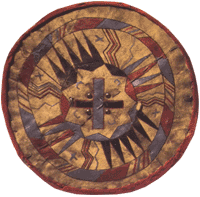





The Osage Nation is a Native American tribe in the United States, which is mainly based in Osage County, Oklahoma, but can still be found throughout America.
The Osage called themselves Wassasi, Children of the Middle Water. The name Osage comes from a French corruption of the tribal name.
Their Osage language belongs to the Siouan branch of the Hokan-Siouan stock of Native American languages, now spoken in Nebraska and Oklahoma. They originally lived among the Kansa, the Ponca, the Omaha, and the Quapaw in the Ohio Valley. The tribe probably separated from the closely-related Kansa not long before Europeans first encountered them. The Osage developed a typical Plains Indian culture with a distictive tribal division between meat-eating Wazhazhe and vegetarian Tsishu.
Many of the Osage had migrated to the Osage River in western Missouri by 1673, living near the Missouri River. Alongside the Kiowa, Comanche, and Apache, they dominated over western Oklahoma. They also lived with the Quapaw and Caddo in Arkansas.
The French encountered the tribe in Missouri during the late 1600s. As experienced warriors, they allied with the French against the Illinois (disambiguation) during the early 1700s.
Friendly relations with the Osage enabled fur trader René Auguste Chouteau to extend his business considerably. He monopolized trade with the tribe from 1794 to 1802.
Lewis and Clark reported that in 1802, the tribe comprised the Great Osage on the Osage River, the Little Osage upstream, and the Arkansas band on the Vermillion River (a tributary of the Akransas River). The tribe then numbered some 5,500.
Wealthy fur trader Jean Pierre Chouteau, the half-brother of René Auguste, became United States agent for the tribe in 1804 He founded the Saint Louis Missouri Fur Company in 1809 with a family member, Auguste Pierre Chouteau. The Spanish imprisoned Auguste in Santa Fe, New Mexico in 1817, but released him after several months. He actively traded with the Osage and made his home at Salina, Oklahoma.
The Osage prohibited the hostile Kickapoo from entering onto their Missouri reservation, keeping them in ceded lands in Illinois. Choctaw chief Pushmataha had a notable career as a warrior against the Osage tribe. The Five Civilized Tribes removed to the Indian Territory clashed briefely with the Osage after arriving on the Trail of Tears. Later Kiowa warriors, allied with the Comanche, raided the Osage, Navajo, Texas, and Durango, Mexico.
The tribe began concluding treaties in 1810 that eventually ceded their tribal territory across Missouri, Arkansas, and Oklahoma. They first moved onto a southeast Kansas reservation, on which the later city of Independence, Kansas now sits.
They later settled onto the Osage Indian Reservation that comprises Osage County, Oklahoma, in the north-central portion of the state between Tulsa, Oklahoma and Ponca City, Oklahoma. Tribal members now hold title to their own land on that reservation. Unlike most other tribes, the Osage prospered on their reservation lands. Substantial oil reserves, discovered on their vast lands in the early 1900s, ensured their wealth.
Ballerina Maria Tallchief, an Osage born in 1925 in Fairfax, Oklahoma, contributed greatly to the success of ballet dance in America. Her younger sister, Marjorie Tallchief, also performed as a dancer.
Today, the Osage Nation claims more than 10,000 members. The Osage Museum in Pawhuska, Oklahoma--the oldest extant tribal museum in the country--documents their history.
